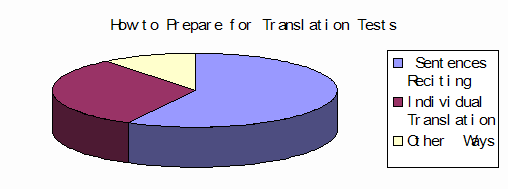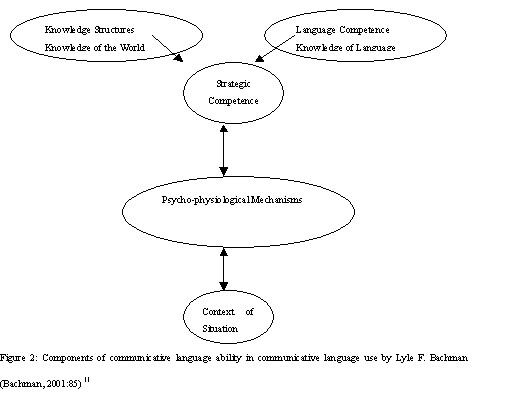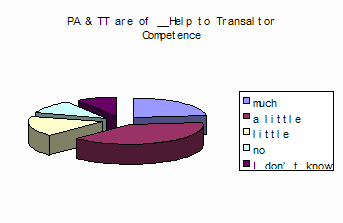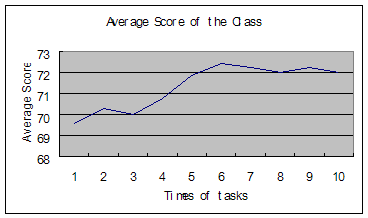| |
Front Page |
|
| |
|
|
Cultivating Translator Competence: Teaching & Testingby Li Haiyan | ||||||||||||||||||||||||||||||||||||||||||||||||||||||||||||||||||
|
Abstract: The writer introduces portfolio assessment into translation teaching and elaborates on the proposal that translator competence should be cultivated through the integration of translation teaching and testing. The writer puts forward several suggestions on how to apply portfolio assessment to translation teaching on the basis of questionnaires and her teaching practice. Keywords: Translation Teaching (TT) Translation Testing (TTS), Washback, Translator Competence, Portfolio Assessment (PA)
1.1 The Current Situations of University-Level Translation Teaching
Reflecting the two broad constituencies of recruitment and training, works on translation assessment can be divided into two broad categories based on the purpose of assessment: accreditation or education. As this thesis deals with education of student translators, we would like to focus on translation testing (hereinafter TTS) for education. Students' passive learning is not only due to fruitless classroom teaching, but is also related to TTS. Among the varieties of teacher-prepared university-level TTS, classroom testing is closest to TT, and hence, it will be discussed here. Teacher-prepared TTS is traditionally placed at the end of the course as a summative assessment, which will be of no help in students' improvement of their translation skills, for it bears no relation with what students should do to improve their translation skills. TTS might thus be ignored by students as a chance to improve their education. This summative TTS is often regarded as an effective tool for judging students' competence in translation; however, it is unfair to negate a student's diligent efforts because of his failure in one test, especially when the reliability of the test is questionable. TTS is rather unreliable when different graders give widely different grades. Even if many teachers realize that their assessment and evaluation procedures are important to their teaching, too many lack the requisite skill for developing and using them (Guillickson, 1984; Stiggins, 1999; Stiggins & Bridgeford, 1985).4 Lacking knowledge in educational measurement impedes effective TT, for poor testing seriously weakens what is otherwise good teaching. For example, when designing the contents of TTS, some instructors may pay more attention to the students' skill of memorizing rather than their strategic competence in the translation process. Instead of stressing translation methods, students are encouraged to memorize those so called "vital facts in translation," as "who translates what in which year." Hence, TTS turned out to be the measurement of students' recalling facts instead of their strategic competence in translation. Another factor in students' passive learning of translation is the separation in content between TT and TTS. It is not unusual that poor assessment practices divert students' efforts from the pursuit of instructional objectives. Since TTS has little relation with what they have learned in each class, students either prepare for it aimlessly or give up their preparation altogether. The worst result is that they won't even care about the instructor's lecture. The data of the pie chart5 below (see Figure 1) is gathered from sophomores of Shanghai Institute of Business Administration and reflects the approaches that English majors adopt in their preparation for TTS. More than half of the students prepare for TTS by reciting sentences, which have been pointed out by their teachers as important for TTS.
1.3.1 Definition of washback Teaching, learning, assessment, and evaluation impact all of us in many ways. "Impact" refers to any of the effects that a test may have on individuals, policies, or practices, within the classroom, the school, the educational system, or society as a whole. "Washback" (also known as 'backwash') is sometimes used as a synonym of "impact," but it is more frequently used to refer to the effects of tests on teaching and learning.6 Despite the warnings of Madaus (1988), Raimes (1990), Perice (1992) and other general educationalists about the negative effects of testing, some language educators see washback in a positive way. Swain (1985) recommends that testers "work for washback." Pearson (1988) regards tests as "levers for change"; similar ideas have been expressed by Li (1990), Wesche (1987), and Allen (1949).7
It is generally accepted that "high-stakes" tests8 will influence the behavior of students and teachers, as well as their perception of their own competence and worth. It may exert such an influence on the average teacher as to be instrumental in determining the content as well as the ways of training before the test takes place. This may lead to "test-centered" teaching, rather than "competence-centered" teaching. However, the negative effect of such "high-stakes" tests may be reduced through proper measures. Teacher-prepared TTS, as "low-stakes" tests, might also have an overall washback on TT. Crooks (1988) believes that classroom testing can have a positive effect on learning if teachers stress the need for "deep learning" rather than "surface learning," use evaluation to assist students rather than to judge them, use feedback to focus students' attention on their progress, set high but attainable standards, and select evaluation tasks to suit the goals.9 In addition, a well-constructed classroom test might provide the students with an opportunity to prove their abilities in performing certain tasks in the translation classroom. Provided that details of their performance are commented on, students should be able to learn from their weaknesses as well as from their group partners and know how to improve their next translation. Last but not least, teacher-prepared TTS contributes to students' learning by communicating with students through the materials assessed and tasks required and serves as an indication of what the students' learning targets ought to be. A classroom assessment, which sets out to measure students' performance in translation as fairly as possible, can be effectively used to motivate them. In general, passive learning leads to poor results in TTS and TT. The combination of proper TT and TTS can motivate students and stimulate their participation. TTS should bear more responsibilities in cultivating student translators than the measurement of students' competence. We do not wish to argue whether TTS to TT washback is good or bad, but to enhance its positive effects and reduce its negative effects through the instructor's thoughtful development of TT and TTS. The usefulness of TTS to TT washback has been amply recognized. The National Council on Measurement in Education, the American Federation of Teachers, and the National Education Association have proclaimed that "student assessment is an essential part of teaching, and good teaching cannot exist without good student assessment" (Sanders, et al., 1990: 30)10
The aim in training student translators is, therefore, to encourage them to make proper strategic decisions in applying their knowledge of the world and languages (the source language and the target language) to the context of certain cultures under the influence of their psycho-physiological mechanisms. Strategic competence may be gained through translating practice and participation. Therefore, both TT and TTS serve the same objective of translator training: to cultivate the students' self-driven competence in learning translation.
3.1 Definition of the Portfolio Assessment Portfolio approaches to assessing literacy have been described in a wide variety of publications, so that many descriptions of portfolios exist (Flood & Lapp, 1989; Lamme & Hysmith, 1991; Matthews, 1990; Tierney, Carter, & Desai, 1991; Valencia, 1990; Wolf, 1989). Generally speaking, a literacy portfolio is a systematic collection of a variety of teacher observations and student products, collected over time, that reflect a student's developmental status and progress made in literacy.14 Using the characteristics of portfolios, we can easily adapt literacy portfolio assessment (hereinafter PA) to TT. A translation portfolio may be defined as a systematic collection of students' translations or reports of tasks to represent a variety of students' achievements in the translation course over a specified period of time. It may include the students' actual products, a statement of why each translation is included and the criteria used in evaluating them. It is not a random, but systematic, collection of students' products in that the student's products are related to major instructional goals.
PA creates a real sense of bringing assessment into harmony with instructional goals, with its characteristics of an integrated set of objectives, higher-order outcomes of tasks, and students' participation. PA is also helpful to instructors in TT. As an indispensable teaching aid to TT, PA may facilitate teachers' task of implementing their teaching plans and reaching their teaching objectives. PA may also offer first-hand authentic data on students' competence in translation, evaluation of TT and his completion of the translation syllabus. In addition, as an extremely valid measure of students' translation, PA, when passed on to the next year's instructor, helps that instructor and provides the students with a feeling of continuity. Therefore, teachers who emphasize such a dynamic type of testing as PA may promote a more efficient learning environment and contribute to making tests less traumatic and more interesting. Moreover, portfolios can serve to promote student self-understanding (Frazier & Paulson, 1992),15 may involve students in the assessment of their achievements, and create a record of continuous improvement. By retaining these works in a portfolio, we can demonstrate not only the final level of student achievement, but also what it took to get there (Kubiszyn & Borich,2003).16 Hence, portfolios can reveal something about students' persistence, effort, willingness to change, skill in monitoring their own learning, and ability to be self-reflective. In addition, the portfolio might also provide students with a sense of accomplishment, which may encourage them to invest more time and effort in learning how to translate.
3.3.1 How to organize the translation classroom? To deal with student translators' passive learning, instructors should make an effort to provoke students' thoughts in the process of forming their psychological schemata as translators. Students' thoughts can be best stimulated through discussion and arguments, which demand their cooperative learning. Moreover, cultivation of student translators' competence can only be achieved through practice. As translation practice tends to be more and more vocationally biased, the authentic task becomes a must. Furthermore, teaching objectives should be the education of student translators. The task, as a basic PTT unit, should be organized to fit the requirements of the translation syllabus, the students' competence, and their future occupation. All those factors work together to form three components of the TT classroom-- cooperative learning, practice-based learning and task-based learning, and they also serve as the basis of portfolio assessment.
Traditionally, the instructor assesses each test and ranks the students. The students are passive and they have no alternative in taking test. While TT aims to cultivate students' self-driven competence, PA ought to encourage students' participation. Under the context of cooperative learning, students work together not only to complete their task but also to make comments on their achievements. This raises student self-awareness of translation evaluation, which is a must for a professional translator. The better students can judge their own or their peers' work, the better they will appreciate a good translation. Such evaluation competence may help students produce better translations. Therefore, the students' work might be assessed either by the instructor, or by the students themselves in portfolio assessment. When students are allowed to participate in the assessment of their own works, they may have two options: self-assessment and peer assessment. Self-assessment is essential to learning on the assumption that it is very difficult for students to achieve a learning goal unless they understand that goal and can assess what they need to reach it. Asking students to assess their own progress is one way of initiating them to see their work objectively. Peer assessment is also effective in that students are effective revisers and judges of each other's work. They may not be asked to give a grade to the work, but they can find areas in the translation that are not clear or which they themselves translated differently. Any disagreement about the answer is thoroughly and openly discussed until agreement is reached. Besides, interchange of opinions in peer discussion is the best way to sharpen the students' thinking and make their minds open and alert. In addition, when they collaborate genuinely and assess each other's work, students develop social skills and learn how to establish a network of contacts. In fact, the instructor can understand no more about the students' shortcomings than themselves. As shown in the Figure 3, most of students impute their translation mistakes to poor choice of words. while their instructors will mention other alternatives: improper style and the other mistakes. This is quite understandable, as it is hard for the instructors to be aware of the progress of a class of nearly 100 students. Therefore, students might be the best judges to their own shortcomings.18
When the criteria are discussed, it always reminds us of the translation standards ranging from Yan Fu's three-character standard,19 Tytler's principles,20 and Nida's "dynamic equivalence principle" (Nida and Taber, 1982:200).21 A fuzzy area exists in standardization of translation quality. As House (1981:64) describes it, "it seems unlikely that translation quality assessment can ever be objectified in the manner of natural science." It is prudent, therefore, to talk about the adequacy of a translation rather than the degree of equivalence. Quality is relative (except regarding accuracy), and the end user (i.e. client) imposes his own subjective preferences of style in the target text.22
Feedback from instructors to students' might determine whether the TTS to TT washback is positive or not. Only those comments that provide detailed descriptions of what should be done are effective. Such clear comments may encourage students to believe that they can meet the requirements of their teachers. Such feedback may enhance students' translation education, both directly through their efforts that may ensue and indirectly by supporting the students' motivation to exert such efforts, which might have more fruitful influence on their improvement. As far as PA is concerned, ranks or marks with descriptive comments can be given together on the overall analysis of the students' competence as well as their efforts in learning how to translate. The assessment of each task functions both to assess their current achievement and to indicate what the next step in their learning trajectory should be. Therefore, it is suggested that the teacher should give more descriptive comments on the students' translation and hints on how to improve their translation as well as how to finish their task more effectively. Students must be taught how to do things right rather than being punished for what they have done wrong, and at the same time they might learn how to comment on each others' work critically based on certain criteria.
The 35 subjects are sophomores of the Business English Department of Shanghai Institute of Business Administration majoring in English; they have no experience in translation practice. Students are preparing themselves to be translators at business companies. Since the course is focused on job-related translation tasks, the task is to be related as closely as possible to the student translators' potential work environment. 4.2 Operationalization During the completion of tasks, we make students prepare themselves for processing information. On the basis of the above-mentioned correctness criteria, we have clear understanding of the students' weaknesses and strengths, taking the difficulty of translation into consideration. At the same time, we make each group busy correcting their own mistakes. We design tasks on the basis of the latest mistakes exposed in the students' translation or their reports. Translation learning, therefore, proceeds in a dynamic manner with the students' participation. In the post-task stage, students are required to have more business terms gathered and comparison made between the different versions. The students' home assignments become a part of their portfolios for the final evaluation.
Figure 5:25 PA & TT and Translator Competence
According to the grades gathered in the each task throughout the whole semester, we drew the following graph (see Figure 6),26 taking the times of tasks and each group's grades into consideration. Although the grades of each group fluctuate greatly, the upward trend of average score of the whole class can be seen in the graph. Based on the students' feedback and their grade statistics, we can conclude that this integration of TT and TTS is of some value.
Figure 6: Task Completions and Translator Competence
In this thesis, the writer intends to seek an effective way of cultivating the university students' self-driven competence in learning translation through the integration of TT and TTS. TTS should be regarded as an effective and indispensable method in training student translators. Taking the positive TTS to TT washback into consideration, instructors might regularly use TTS to help diagnose students' strengths and weaknesses, to assess their progress, and to assist in evaluating their achievements. In addition, TTS can also be frequently used as a source of information in evaluating the effectiveness of different approaches to TT. As a source of feedback on teaching and learning, TTS can thus provide useful input into the TT process. Therefore, education of student translators can be conducted through the instructor's rotating the healthy teaching circle of TT and TTS. Otherwise, separation between TT and TTS may prevent the instructor from teaching and the students from learning effectively.
|
||||||||||||||||||||||||||||||||||||||||||||||||||||||||||||||||||
|
|





